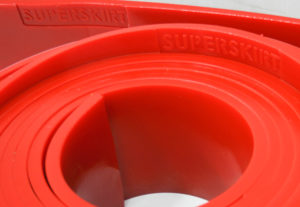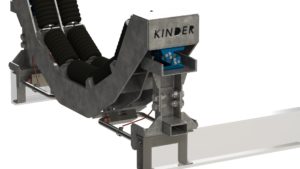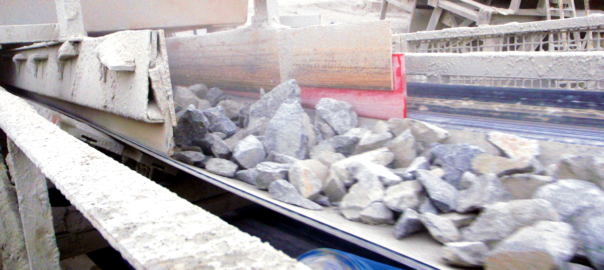As mining companies continue to search for cost efficiencies at their operations against a backdrop of subdued metal prices and uncertainty related to the onset of COVID-19, bulk materials handling equipment provider, Kinder Australia, is warning them to focus on sourcing engineered and high-performance components that have been optimised for the application at hand.
Today’s global economy means when sourcing bulk handling equipment, operators are spoilt for choice with the vast selection of conveyor component suppliers and access to highly engineered and innovative solutions to advance their end to end handling processes, Kinder Australia says.
“For most operators, price alone is often the motivator for purchase,” it said. “However, buyer beware, lower price products are more often ‘copycat’ and ‘knockoffs’ offering on-par standards and functionality benefits to the original product.
“The reality of inferior, lower price copycats is the untold costly, irreversible damage these products can have to the conveyor structure, conveyor belts itself and the unscheduled maintenance and productivity downtime to replace these inferior products…only to be discovered shortly after the installation hurdle.”
When considering cost cutting on a corporate level, many plant and equipment suppliers are also challenged by the dilemmas of large corporate purchasing department heads who are ignorant of the engineering differences between genuine and counterfeit products, and quite often make their purchasing decisions based solely on price, often at the expense of quality, Kinder Australia says.
Trusted quality
In the case of lower cost polyurethane skirting and anti-wear lining products, on the surface, they look and feel the same as the genuine engineered polyurethane skirting.
“However, conduct a quick internet search and you’ll soon realise the countless suppliers using sub-standard/cheaper manufacturing practices to design, manufacture and market far inferior polyurethane products and conveyor components and pass them off as high-quality engineered equivalents,” the company said.
The use of non-genuine engineered conveyor components can lead to frequent production stoppages, belt wear damage, other unpleasant material spillage and safety hazards, according to the company.
Neil Kinder, Kinder Australia CEO, says: “The mark of quality in our industry is ISO 9001 certification. These international standards provide assurance and commitment to our diverse customer base that Kinder provides highly customer-focused bulk materials handling products and solutions that are safe, reliable and of high-quality standards.”
He added: “Kinder Australia partners with an independent laboratory to facilitate and conduct ASTM D 4060 quality testing and certification of competitive lower cost conveyor components”.
The “Taber Test” carried out by independent testing laboratory Excel Plas, showed Kinder Australia’s K-Superskirt® Engineered Polyurethane abrades less by comparison with the competitor’s polyurethane and is therefore four times more durable than the competitor’s polyurethane tested, according to the company.
This polyurethane has been successfully and effectively installed in a multitude of applications, including the harshest mining environments, delivering significant cost and labour savings to operators globally, Kinder Australia said.
Conveyor planning & engineering design
Conveyor engineering design focuses on providing solutions to customers issues around three key areas: productivity, safety and cost reduction, Kinder Australia says.
Materials handling operators are constantly challenged by increasing production outputs and cost reduction targets. Ensuring the recommended solution is fit for purpose and practical from a cost, installation and maintenance perspective are also key engineering considerations.
Cameron Portelli, Senior Mechanical Engineer at Kinder Australia, says: “The issue of poor belt life is often encountered during on-site evaluation; it’s one of the top conveyor problems seen by our mechanical and field applications engineers.”
Conveyor Belt Support Systems are designed to protect this expensive and important asset, according to the company.
At the critical conveyor transfer points, having the full force of the impact absorbed rather than resisted means the impact load zone belt support system below the belt takes the hit rather than the conveyor belt itself. This effectively improves and extends the wear life of all conveyor components such as the belt, idlers and structure life and makes for a quieter transfer in serious applications.
Kinder’s K-Dynamic Impact Idler/Cradle Systems (pictured) target conveyor transfers as “burden is being accelerated due to fall and changes in direction from one system to the next which prevents steady state flow and requires additional thought into supporting the belt to improve the life of the belt and transfer components”, says Portelli. 
“It would be wise to start from the problem at hand and work backwards to isolate the root cause. This may involve chute design improvements before any transfer chute sealing options should be looked at.”
Another regular occurrence encountered on-site are grooves on the top cover created by product getting under hard and soft skirts, particularly at the transfer point.
This problem can often be solved through the installation of a combination of conveyor skirting and sealing & conveyor belt support system, which can also effectively eliminate dust and material spillage and create work environments that are productive, clean and safe, Kinder Australia said.
This is where SOLIDWORKS® Simulation Finite Element Analysis, an upgrade to the basic software licence, can accurately predict and design solutions that mimic real-world applications and scenarios.
“With this powerful information, industry lead mechanical engineers have the necessary tools to analyse results, plan and expertly optimise future designs, geared at maximising productivity improvements and efficiency gains,” the company said.
When planning, designing, and recommending solutions, safety is an integral part in delivering operational productivity and efficiency, with engineers ethically and legally responsible for the solutions they recommend and implement.
“In some cases, if all reasonable risks are not considered, the risk of legal action against the company and the individual could have massive financial ramifications, along with the ongoing damage to the brand and stance in the industry,” Kinder Australia said.
Portelli says all of Kinder Australia’s new and innovative designs are stringently risk assessed for hazards at the critical installation, operational and maintenance stages.
“Through the effective use of SOLIDWORKS, Simulation Finite Element Analysis tools can potentially reduce any ongoing risks by analysing the specific areas where a design can be better improved,” he said.
Portelli elaborated on this: “This software can also assist clients to see the overall bigger picture, as well as take into consideration future installation and maintenance issues.
“Although SOLIDWORKS doesn’t produce all scenarios, it can be a beneficial tool for starting a conversation with clients. This mostly centres around how the solution will function after installation and its serviceability.”
In recent years, materials handling conveyor components supplier Kinder Australia has made significant investments in engineering design through the expansion of its mechanical engineering team to three staff. The engineering team’s capabilities extend to high proficiency in Helix Conveyor Design and AutoCAD, it said.
These tools can help make decisions on the drive power requirements; belt tensions and a suitably specified belt; specifications for suitably sizes idler rolls; take-up dimensions and gravity take up weight requirements; specifications for a suitable gearbox; and the design of pulleys to meet standards AS1403 (shafts) and limit stresses in the shells.
Neil Kinder concluded: “For the past 30 years, the driver for the business has been the resolution and advancement of our customers end-to-end handling processes, harnessing our engineering expertise and keeping abreast of innovative and emerging industry technologies.
“Developing a connection with our diverse customer base who have differing application needs and expectations through on-site visits, our highly technical mechanical engineering and field applications team become better at solving our customers problem and measuring up the solution.”







